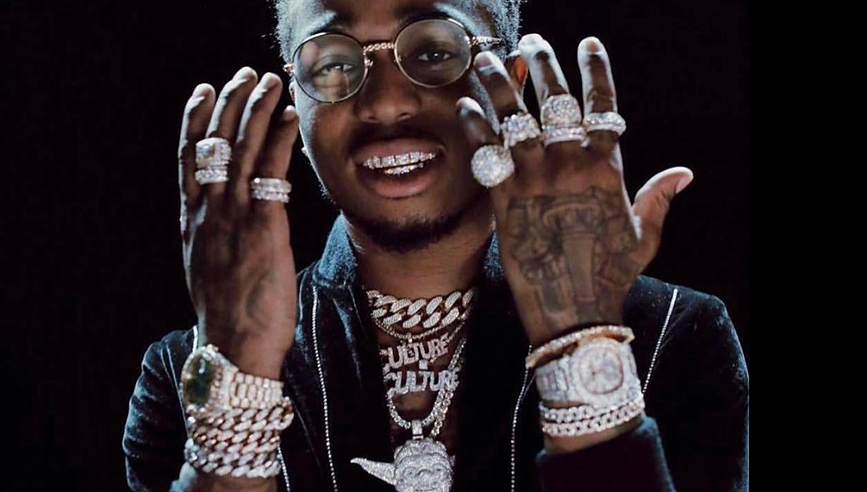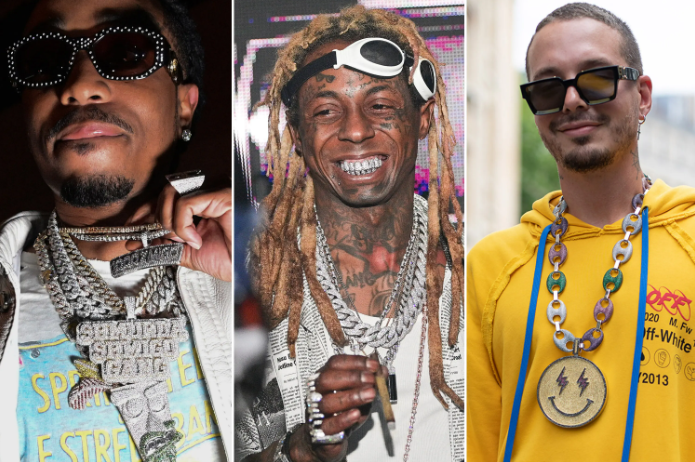Hip-hop culture is a dynamic and captivating realm that has redefined music and significantly influenced fashion and lifestyle trends.
Within this vibrant subculture, one of the most distinctive and visually striking features is the penchant for rappers to adorn themselves with extravagant, oversized jewelry.
This practice, often characterized by the donning of glistening chains, oversized pendants, and blinged-out accessories, has become synonymous with the genre, capturing the attention of enthusiasts and critics alike.
To understand the phenomenon of rappers wearing big jewelry, it’s essential to delve into the historical roots of hip-hop culture and explore the intriguing connection between jewelry and identity.
Throughout the years, iconic rappers such as Jay-Z, whose affinity for diamond-studded pieces epitomizes opulence, Lil Wayne, a pioneer of the “Grillz” trend that redefined dental accessories, and Tupac Shakur, who integrated meaningful symbols into his jewelry, have not only elevated their status through their musical prowess but also left an indelible mark through their audacious jewelry choices.
These artists have contributed to the intricate tapestry of hip-hop’s visual language, showcasing the intertwined relationship between personal style, cultural expression, and the allure of opulent adornments.
Historical Roots of Jewelry in African and Black Cultures
The intricate tapestry of jewelry’s historical significance within African and Black cultures is a testament to the deep-rooted connections between personal adornment, cultural expression, and the preservation of identity.
Ancient African Civilizations
Ancient African civilizations had a profound and enduring relationship with precious metals, particularly gold.
These civilizations, such as Nubia in Sudan and the empires of Ghana, Mali, and Songhai in West Africa, flourished for centuries and had access to abundant sources of gold. Gold was used as a symbol of wealth and power and played a central role in their jewelry craftsmanship.
Skilled artisans created intricate necklaces, bracelets, rings, and other adornments that showcased their craftsmanship and reflected the luxury of their societies.
The artistry of these ancient African jewelry pieces is still admired today, highlighting the enduring legacy of these civilizations’ craftsmanship and their affinity for precious metals.
Symbolism of Jewelry in African Cultures
Jewelry in African cultures is not merely decorative; it carries profound symbolic significance. Jewelry pieces are often worn to convey specific messages or mark significant life events.
For instance, necklaces, earrings, and bracelets may be worn to celebrate weddings, childbirth, or initiation ceremonies into adulthood. In many African communities, beads play a prominent role in jewelry design, and the colors and patterns of these beads carry distinct meanings.
Each bead color may symbolize attributes like courage, fertility, protection, or even social status. Thus, jewelry is an assertive communication means expressing one’s identity and cultural heritage.
The Transatlantic Slave
The transatlantic slave trade inflicted immeasurable suffering on African communities, forcing millions of people to be displaced from their homelands.
This tragic period also resulted in losing invaluable cultural artifacts, including precious jewelry. As they endured the brutal journey across the Atlantic, many enslaved Africans were stripped of their belongings, including their cherished jewelry.
Consequently, much of this cultural heritage was lost or dispersed across different regions, making it challenging to trace and preserve these artifacts today.
Despite these hardships, African and Black communities have continued to preserve and celebrate their cultural traditions, including jewelry-making, as an integral part of their identity and heritage.
The Rise of Bling in the Early Hip-Hop Era
The late 1970s and early 1980s marked the genesis of a cultural revolution that would reshape the world: hip-hop. Emerging from the urban neighborhoods of New York City, hip-hop transcended musical boundaries to become a lifestyle, influencing fashion, language, and societal norms.
Emergence of Hip-Hop in the Late 1970s and Early 1980s
The late 1970s and early 1980s marked the birth of hip-hop culture in the South Bronx, New York.
This dynamic cultural movement was born out of the creativity and resilience of marginalized communities, primarily African-American and Latinx youth.
Hip-hop encompassed four key elements: rap music, breakdancing, graffiti art, and DJing. It provided a platform for these communities to express themselves and their experiences in a world marked by economic hardships, crime, and social inequality.
First Instances of Rappers Wearing Flashy Jewelry
As hip-hop music began to surge in popularity and transition from local street performances to commercial success, the early hip-hop era saw the emergence of rappers adorned in flashy jewelry.
Artists such as Grandmaster Flash and the Furious Five and Run-DMC rose to iconic status during this period for their groundbreaking music and memorable and distinctive fashion choices.
These pioneers of hip-hop culture were among the first to boldly incorporate oversized gold chains, ornate rings, and other extravagant jewelry pieces into their wardrobes, effectively making jewelry an integral and defining aspect of their public image.
Their sartorial choices sent a powerful message, symbolizing personal style and the aspiration for success and recognition.
In this way, jewelry became a visual embodiment of the dream of transcending their humble beginnings, achieving prosperity, and leaving an indelible mark on the music industry and popular culture.
Jewelry as a Symbol of Success and Breaking Out from Poverty
In the context of hip-hop culture, jewelry became a potent symbol of success and a tangible representation of the American Dream.
Many early hip-hop artists hailed from economically disadvantaged backgrounds and experienced firsthand poverty and discrimination. Their newfound fame and fortune, often associated with record deals, tours, and endorsements, were celebrated by donning flashy jewelry.
These pieces, particularly gold chains and large medallions were not merely fashion statements but declarations of triumph over adversity.
The act of wearing such jewelry conveyed the message that, despite their humble beginnings, these artists had achieved remarkable success through their talent, determination, and creative expression.
In neighborhoods with limited economic opportunities, hip-hop and its association with opulent jewelry symbolized hope and the potential for a brighter future.
The bling culture of the early hip-hop era emphasized the idea that individuals could transcend their circumstances and rise to prominence by harnessing their talents and pursuing their dreams.
This narrative resonated deeply with young people in disadvantaged communities, inspiring them to believe in their potential for success and self-expression.
Socio-Economic Significance
Jewelry has significant socio-economic implications within African and Black cultures, representing success and wealth. It often contrasts against poverty and systemic disadvantages while embodying the aspiration to rise and the desire to display one’s ascent.
Jewelry as a Marker of Success and Wealth
Historically, jewelry has been intricately linked to success and wealth in African and Black cultures. It’s not just about adornment; it displays one’s accomplishments and social standing.
Elaborate jewelry pieces are often associated with affluence and prosperity. These ornaments range from exquisite gold necklaces and bracelets to diamond-studded earrings and watches.
The choice of jewelry can reflect an individual’s financial success, professional achievements, and overall status within their community.
When someone wears such jewelry, it’s akin to their success story for all to see. It’s a visual testament to their hard work, entrepreneurial endeavors, or notable accomplishments.
Contrast Against the Backdrop of Poverty and Systemic Disadvantages
One cannot overlook the stark contrast between the opulent displays of jewelry and the backdrop of poverty and systemic disadvantages that persist in many African and Black communities.
These disparities have deep historical roots, often stemming from colonization, slavery, and ongoing systemic racism.
Within these communities, you may find individuals wearing dazzling jewelry alongside others struggling with limited access to quality education, healthcare, and employment opportunities.
This contrast highlights the complex socio-economic landscape within these communities, underscoring the enduring effects of systemic inequalities.
It serves as a reminder of the persistent challenges many individuals face while showcasing the resilience and determination to overcome them.
Aspiration to Rise and Desire to Display the Ascent
For many individuals in African and Black communities, the ownership and flaunting of extravagant jewelry represent aspirations for a better future. It’s a tangible symbol of the hope for upward mobility and social advancement.
Jewelry is a beacon of possibility in a world where obstacles and systemic barriers may seem impossible. It embodies the idea that, despite facing adversity, individuals can achieve success, prosperity, and recognition.
Wearing such jewelry isn’t just about showcasing personal achievements; it’s about inspiring others within the community to strive for similar accomplishments. It symbolizes the collective determination to break free from socio-economic limitations and create a brighter future.

Identity and Branding
Jewelry is pivotal in personal branding among rappers and artists within the hip-hop culture. It serves as a means of setting themselves apart, creating distinctive identities, and leaving a lasting impression on their audience.
Here, we’ll explore how personal branding in rap is intertwined with jewelry, providing examples of rappers with signature pieces and delving into the role of jewelry in music videos and public appearances.
Personal Branding: Rappers Setting Themselves Apart
In the competitive world of hip-hop, personal branding is paramount. Rappers often use their unique style, including jewelry, to establish a distinct identity that distinguishes them from their peers.
This extends beyond just their music; it encompasses their entire persona, fashion choices, and jewelry preferences. Rappers leverage jewelry to reflect their personalities, values, and stories.
For instance, some may wear bold, oversized pieces to convey a message of luxury and success. In contrast, others may opt for more understated, symbolic jewelry to express deeper meanings or cultural affiliations.
Ultimately, these choices help craft a unique brand image that resonates with their audience.
Examples of Rappers with Signature Jewelry Pieces
Several rappers are known for their signature jewelry pieces that have become iconic within the hip-hop community.
One such example is the late Notorious B.I.G., who was often seen wearing his distinctive “Jesus piece” necklace—a large gold pendant depicting the face of Jesus Christ. This piece became synonymous with his persona and featured prominently in his music.
Similarly, Lil Uzi Vert gained attention for his extravagant diamond forehead implant, boldly expressing individuality and self-expression.
These rappers’ signature jewelry pieces have become symbols of their branding, contributing to their legendary status within the genre.
Role of Jewelry in Music Videos and Public Appearances
Jewelry plays a prominent role in music videos and public appearances by rappers. Music videos, in particular, are a medium where artists can showcase their wealth and style through their jewelry choices.
Flashy chains, sparkling watches, and extravagant rings are often featured, reinforcing the image of success and luxury.
These visuals align with the lyrical themes of many rap songs, which often explore themes of wealth, power, and success.
Public appearances, including red-carpet events and live performances, offer rappers a platform to make bold fashion statements through their jewelry, ensuring their branding extends beyond their music.
Cultural Influence and Trends
The influence of hip-hop on fashion and mainstream culture has been profound, shaping trends and creating a lasting impact. This cultural phenomenon extends to the evolution of jewelry styles in hip-hop and the trends set by rappers that have influenced the broader fashion scene.
Influence of Hip-Hop on Fashion and Mainstream Culture
Hip-hop culture has transformed fashion and mainstream culture since its emergence in the South Bronx during the 1970s.
With their unique voices and personal styles, hip-hop artists began to redefine the boundaries of fashion. They introduced a fusion of streetwear, athletic wear, and luxury brands, blending high and low fashion in ways that challenged traditional norms.
Baggy pants, oversized t-shirts, baseball caps, and extravagant jewelry characterized this style revolution.
Hip-hop’s embrace of bold, flashy fashion elements quickly caught the attention of the mainstream, leading to the widespread adoption of these styles.
Evolution of Jewelry Styles in Hip-Hop
Jewelry has been a hallmark of hip-hop fashion from its inception. Rappers used jewelry as a symbol of success and a form of self-expression and identity.
In the early days, artists like Run-DMC popularized the iconic gold rope chains and chunky “Dookie” rope chains. As hip-hop evolved, so did jewelry styles.
The 1990s saw the rise of larger-than-life, diamond-encrusted pieces, such as oversized medallions, grillz (gold or diamond-studded dental jewelry), and massive diamond rings.
In recent years, there has been a shift towards more intricate and personalized jewelry pieces. Customized pendants, nameplates, and unique symbols have become popular among rappers, allowing them to tell their stories through jewelry.
The blurring of gender lines in fashion has also influenced jewelry choices, with male and female rappers embracing various jewelry styles.
Trends Set by Rappers Influencing the Broader Fashion Scene
Rappers have consistently set trends that permeate the broader fashion scene. Some notable examples include:
- Streetwear: The hip-hop community was pivotal in popularizing streetwear brands like Supreme, Off-White, and BAPE. These brands have since become mainstream fashion staples.
- Sneaker Culture: Hip-hop artists have been at the forefront of sneaker culture, making certain brands and styles iconic. The Air Jordan line, for instance, was catapulted to legendary status by its association with Michael Jordan, who was celebrated in hip-hop.
- Luxury Brands: Many luxury fashion houses, such as Gucci and Versace, have embraced hip-hop culture and collaborated with rappers to create unique collections and accessories, bridging the gap between high fashion and streetwear.
- Layering and Mix-and-Match: Rappers have popularized the art of layering, mixing high-end and affordable fashion items to create distinctive looks. This approach has influenced how people style their outfits across various budgets.
- Minimalism and Personalization: Recent trends in hip-hop fashion have seen a shift towards minimalistic and personalized jewelry pieces, emphasizing unique symbols, names, or cultural references.

Criticism and Controversy
While bling culture has undeniably left an indelible mark on the hip-hop genre and its associated fashion, it hasn’t been without its share of criticism and controversy.
Arguments Against the Ostentatious Display of Wealth
The ostentatious display of wealth within hip-hop and entertainment has faced significant criticism from various quarters.
One of the primary arguments against this practice is rooted in societal inequalities and disparities. Critics contend that showcasing extreme affluence can be considered insensitive and offensive, particularly in regions marked by stark income disparities.
Such displays of opulence can accentuate the divisions between the financially privileged and those facing economic hardship.
Furthermore, the public flaunting of wealth can be perceived as a lack of humility. Some argue that it may come across as boastful, arrogant, or even selfish, potentially alienating fans and the general public.
This criticism is often directed towards celebrities prioritizing their material possessions over more socially responsible or philanthropic endeavors.
Additionally, there are practical concerns regarding the safety of artists and individuals who publicly display valuable jewelry and possessions.
The high-profile nature of these displays can make artists susceptible to theft or harm, as they become potential targets for criminals seeking to exploit their wealth.
Concerns About Materialism and Its Influence on Young Fans
Critics are also concerned about the impact of such ostentation on young fans. The excessive emphasis on wealth and material possessions within hip-hop and entertainment can inadvertently encourage materialistic values among impressionable audiences.
Young fans may be influenced to prioritize wealth and material gain over other, more meaningful life goals and values.
The images and messages conveyed by artists who flaunt their wealth can reinforce a perception that success is measured solely by material accumulation.
This can have a lasting effect on the aspirations and attitudes of young fans, encouraging a focus on consumerism and materialism rather than personal growth, education, or community engagement.
Debate Over Better Uses for Money
Another aspect of the criticism surrounding the ostentatious display of wealth pertains to allocating financial resources.
Some argue that the vast sums of money spent on expensive jewelry and lavish lifestyles could be directed toward more socially responsible or philanthropic causes.
The debate revolves around whether the money could be better utilized to address pressing societal issues, such as poverty, education, healthcare, or community development.
Critics argue that the conspicuous consumption of luxury items, while entertaining and impressive, often seems excessive in a world where many individuals and communities continue to grapple with basic needs.
This perspective raises questions about the ethical responsibility of individuals with substantial wealth and whether they should allocate a portion of their resources to contribute to the betterment of society.
Modern-Day Interpretations
Over the past few decades, hip-hop and rap music have experienced a significant transformation in musical style and lyrical content and how artists express their identities and values through fashion and accessories.
New Wave Rappers and Their Relationship with Jewelry
New-wave rappers, often associated with the sub-genres of hip-hop, have brought fresh approaches to jewelry.
While they still appreciate the aesthetic appeal of jewelry, many new-wave rappers place a stronger emphasis on individuality, self-expression, and the underlying symbolism of their pieces.
Instead of simply flaunting wealth, they use jewelry to convey personal stories, cultural pride, and more profound messages.
The Shift from Big Jewelry to More Meaningful, Symbolic Pieces
In contrast to the oversized and flashy jewelry of the past, some modern rappers opt for more meaningful and symbolic pieces. Customized pendants, nameplates, and unique symbols have gained popularity.
These pieces often carry personal significance, representing a rapper’s journey, experiences, or cultural roots.
For example, a rapper might wear a pendant bearing the image of a cultural icon, a representation of a social movement, or a symbol that reflects their values and beliefs.
These choices add depth to their style and enable them to connect with fans more profoundly.
Evolution of the Meaning of Wearing Jewelry
The meaning of wearing jewelry within the hip-hop culture has evolved significantly over time. While it once primarily conveyed wealth and success, it has transformed into a multifaceted form of self-expression.
Today, jewelry communicates one’s identity, values, and cultural affiliations. It has become a canvas for storytelling and a medium through which rappers can connect with their audience on a deeper emotional level.
This evolution reflects the hip-hop community’s changing cultural attitudes and a desire for authenticity and individuality.
Conclusion
Jewelry has multidimensional importance in the colorful fabric of rap culture, weaving together its historical, socioeconomic, and personal branding aspects. It grew from a symbol of ambition and escape to an ornate emblem of victory due to underprivileged populations’ quest for identification and prosperity.
The change from gaudy bling to meaningful items signaled a shift towards authenticity and self-expression as the genre progressed. Today, new-wave rappers use jewelry as a canvas to depict their backgrounds, ancestry, and personal tales, therefore building relationships with their audience.
This adornment’s future in the hip-hop business will be determined by its capacity to continue expressing the genre’s ever-changing narrative while remaining faithful to its historical origins.



